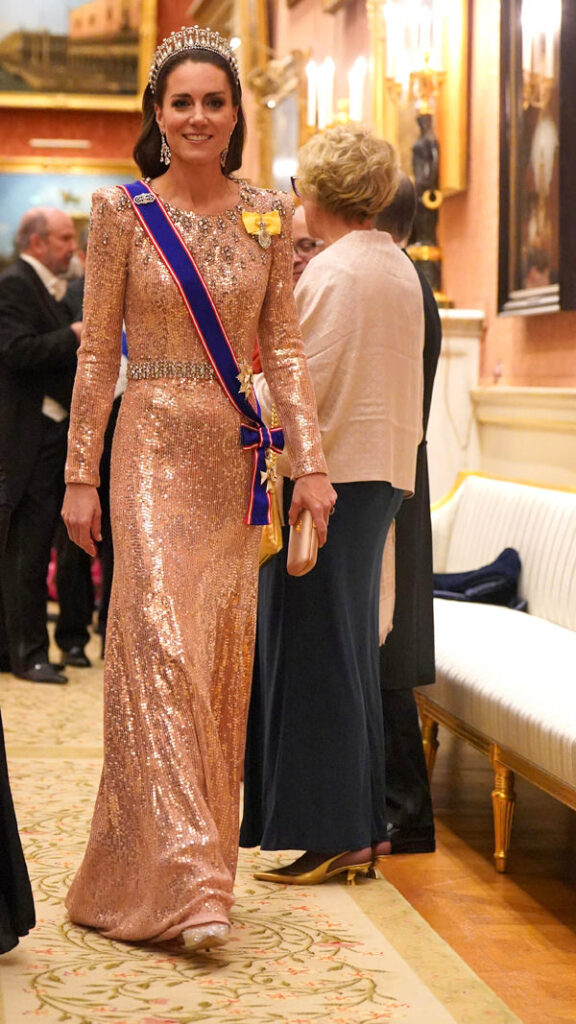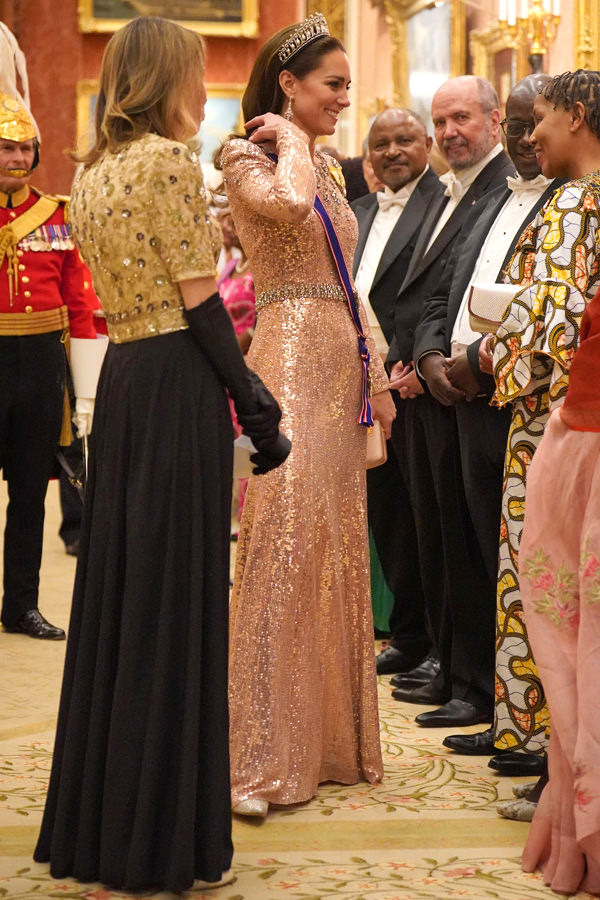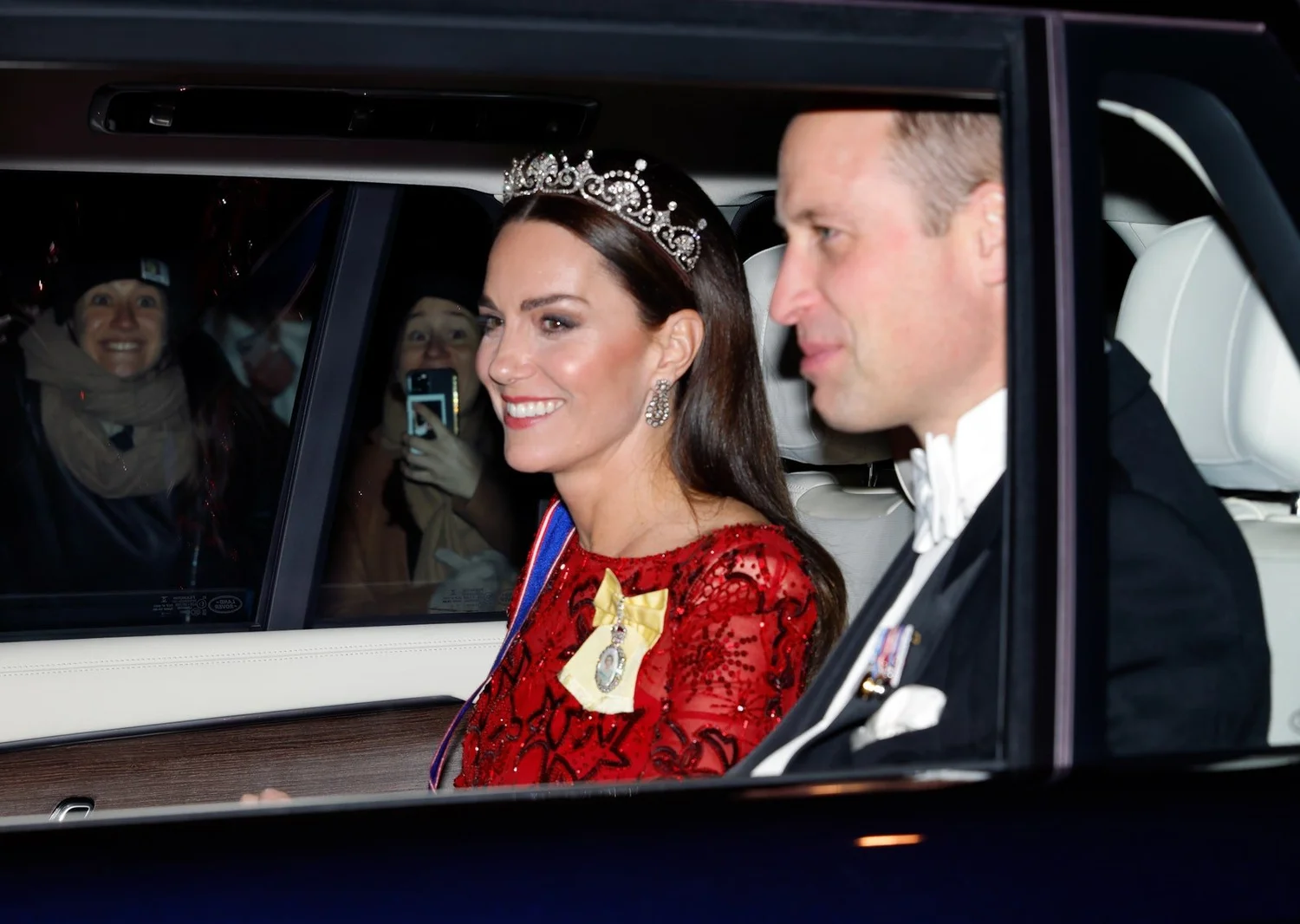Catherine’s Grace Under Pressure: How the Princess of Wales Turned a Diamond Into Diplomacy

There are moments in royal life that transcend jewels and titles. They remind the world why royalty continues to captivate across centuries. Recently, Catherine, Princess of Wales, offered such a moment—when she was faced with an extravagant gift worth more than most homes and responded not with glitter, but with grace.
The Dazzling Offer
It happened at a glittering diplomatic reception, chandeliers shimmering overhead, the air thick with anticipation. A Saudi prince, eager to honor the Princess, presented her with the
Rose of Jeddah—a pink diamond necklace that drew a collective gasp from the assembled dignitaries.
The necklace was extraordinary: a flawless 20-carat Argyle pink diamond at its heart, framed by smaller stones in delicate white gold filigree. Its value exceeded £2 million. But its worth lay in more than carats. To the prince, it was a symbol of respect, prestige, and the long tradition of Saudi hospitality. To the world watching, it was a test of Catherine’s judgment.
A Princess at a Crossroads
Extravagant gifts from foreign leaders are nothing new. Queen Elizabeth II received similar treasures; Diana once dazzled in sapphire suites. Yet times have changed. Since 2003, royal protocol has urged caution, warning against gifts that could suggest undue influence.
For Catherine, the stakes were even higher. She is not just a royal consort-in-waiting, but a global icon, her every move scrutinized in an age of instant headlines and social media storms. To accept a £2 million diamond risked more than whispers—it risked her carefully nurtured image as a modern, relatable royal who wears Zara as readily as couture.
Add to that the global context: Saudi Arabia’s complicated reputation, with human rights questions never far from the surface. Accepting the necklace could be seen as a tacit endorsement. Catherine knew the world was leaning in, ready to dissect every flicker of her expression.
Grace in Action
As the velvet box opened, the hall seemed to pause. The pink diamond glowed under the lights, dazzling, almost impossible to refuse. Yet Catherine did not falter.
Poised in a deep emerald gown, she leaned slightly toward the prince, admiration clear in her voice. “This is truly exquisite,” she said warmly. “The craftsmanship is remarkable. But what touches me most is the spirit of your country’s traditions.”
With that single phrase, she shifted the focus—from opulence to heritage. Rather than bluntly refusing, she gently steered the moment toward cultural meaning. The prince understood at once. With a gracious smile, he signaled to an aide, who stepped forward with another offering: a handwoven indigo silk shawl embroidered with palm fronds and desert roses.
Catherine’s face lit up. She held the fabric close, visibly touched. “This is beautiful,” she said, her sincerity unmistakable. In that instant, what could have been an awkward rejection became a bridge of respect.
The Return Gesture
But Catherine’s diplomacy did not end there. Days later, a package arrived for the prince: a pair of bespoke sterling silver cufflinks crafted in London’s historic Hatton Garden. Each bore a Celtic knot, symbolizing unity and eternity—an emblem of connection across cultures.
Accompanied by a handwritten note in her elegant script, Catherine’s gift carried not only British craftsmanship, but her personal touch. It was reciprocity without extravagance, a gesture of equality that diplomats would later call a “master stroke of soft power.”
The prince was said to be deeply moved, reportedly wearing the cufflinks at a subsequent event. What began as a potential misstep had become a moment of genuine connection.
Why It Mattered
Catherine’s handling of the Rose of Jeddah was more than etiquette. It was a demonstration of what modern royalty must embody.
-
Protocol: By declining the necklace, she upheld royal guidelines designed to protect neutrality.
-
Public Perception: At a time of economic strain in the UK, she avoided the image of extravagance.
-
Global Optics: She sidestepped controversy over Saudi politics while honoring the nation’s culture.
-
Personal Integrity: She reinforced the values she lives daily—authenticity, compassion, and restraint.
Royal historians likened her response to Queen Victoria’s careful diplomacy, but with a distinctly modern twist: shaped by social media, amplified by a world hungry for authenticity.
The World Reacts
Newsrooms across London ran with headlines: “Catherine’s Classy Snub”(Daily Mail), “A Lesson in Royal Grace”(The Times). Saudi outlets praised her respect for tradition, while commentators in Riyadh described the shawl as “a gift elevated to global stage.”
On social media, hashtags like #RoyalDiplomacy and #CatherineClass trended for days. One viral post read: “She didn’t just say no to a diamond. She built a bridge.” Another, from a Saudi fashion blogger, praised the shawl’s craftsmanship and Catherine’s choice, gathering thousands of likes.
Diplomatic analysts were equally impressed. “By choosing cultural meaning over material wealth, she turned a transaction into a dialogue,” said Dr. Aisha al-Mansori, a political analyst in Riyadh.
More Than a Moment
In the end, the Rose of Jeddah was not about jewels—it was about judgment. Catherine’s decision reminded the world that true influence comes not from what you accept, but from what you stand for.
Her choice of a simple shawl over a £2 million diamond necklace wasn’t just protocol. It was principle. A reminder that even in gilded halls, grace can shine brighter than gemstones.
For Catherine, the moment wasn’t about headlines or history. It was about connection—between nations, between traditions, between people. And in that connection, she showed once more why the world leans in when she speaks, acts, or simply smiles.


